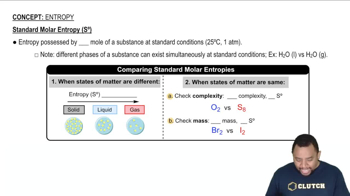Here are the essential concepts you must grasp in order to answer the question correctly.
Standard Entropy (S°)
Standard entropy (S°) is a measure of the randomness or disorder of a system at a standard state, typically defined at 1 bar of pressure and a specified temperature, usually 298 K. It reflects the number of accessible microstates for a given substance, with higher values indicating greater disorder. In chemical reactions, the change in entropy (ΔS°) can be calculated by considering the standard entropies of the reactants and products.
Recommended video:
Entropy Change (ΔS°)
The change in entropy (ΔS°) for a reaction is calculated using the formula ΔS° = ΣS°(products) - ΣS°(reactants). This value indicates whether the disorder of the system increases or decreases during the reaction. A positive ΔS° suggests an increase in disorder, while a negative ΔS° indicates a decrease. Understanding the sign of ΔS° is crucial for predicting the spontaneity of a reaction.
Recommended video:
Gas Phase Reactions and Entropy
In gas phase reactions, the number of moles of gaseous reactants and products significantly influences the entropy change. Generally, reactions that produce more gas molecules than they consume lead to an increase in entropy (positive ΔS°), while those that consume more gas molecules result in a decrease in entropy (negative ΔS°). This concept is essential for analyzing the given reaction, where the number of gaseous reactants and products must be compared to determine the sign of ΔS°.
Recommended video:

 Verified step by step guidance
Verified step by step guidance


